When selecting the best wilderness survival manuals for your gear, I recommend a mix of exhaustive guides like the SAS Survival Handbook and beginner-friendly options like Bushcraft 101. Portable, durable resources such as waterproof pocket guides and quick-reference cards are essential for emergencies. These manuals cover everything from shelter building to first aid. If you keep exploring, you’ll discover which ones suit your needs and how to get the most from each.
Key Takeaways
- Choose comprehensive manuals like the SAS Survival Handbook for detailed techniques and credibility.
- Opt for portable guides such as waterproof pocket cards for quick reference and durability in outdoor conditions.
- Prioritize beginner-friendly resources like Bushcraft 101 and The Essential Skills for foundational knowledge.
- Select guides with visual aids—diagrams, photos, and charts—to enhance understanding and practical application.
- Incorporate specialized manuals like Bushcraft First Aid for emergency medical procedures and natural remedies.
The Essential Skills of Wilderness Survival

If you’re looking for a practical guide that balances beginner-friendly instructions with enough depth for experienced outdoorspeople, “The Essential Skills of Wilderness Survival” by Jason Knight is an excellent choice. I found it incredibly organized, covering key survival priorities like shelter, water, fire, and food, all based on the Rule of Threes. The book offers step-by-step instructions, practical tips, and real-life stories that make complex concepts accessible. With helpful photos and charts, it’s easy to follow along. It emphasizes mental resilience and planning, ensuring you’re prepared for emergencies. Whether you’re new or seasoned, this guide helps build confidence and essential skills for any wilderness situation.
Best For: beginners seeking a clear, organized introduction to wilderness survival skills as well as experienced outdoorspeople looking to reinforce their knowledge and techniques.
Pros:
- Well-structured with step-by-step instructions, practical tips, and real-life stories that enhance learning.
- Includes helpful visuals like photos, charts, and drawings to facilitate understanding and retention.
- Emphasizes mental resilience and preparedness, covering both practical skills and psychological aspects of survival.
Cons:
- Could benefit from more detailed tactics and multiple techniques per chapter with additional visuals.
- Lacks in-depth coverage of wilderness clothing considerations for different environments.
- Some readers may find it less comprehensive than specialized survival handbooks like SAS or Les Stroud’s “Survive!”.
SAS Survival Handbook, Third Edition

The SAS Survival Handbook, Third Edition, stands out as an essential resource for both novice and experienced outdoorsmen who want an extensive, reliable guide to wilderness survival. Authored by John “Lofty” Wiseman, a seasoned SAS soldier with 26 years of field experience, it offers practical skills, mental strategies, and detailed instructions. Covering everything from building shelters and fire-making to orienting oneself in terrain and performing first aid, the book emphasizes preparedness and resilience. Its illustrations and real-life anecdotes make complex concepts accessible. Whether you’re in the wilderness or urban environment, this manual equips you with the knowledge to stay safe, make smart decisions, and survive any emergency.
Best For: outdoor enthusiasts, survivalists, and preppers seeking a comprehensive, practical guide to wilderness and urban survival.
Pros:
- Extensive coverage of survival techniques with detailed illustrations and real-life anecdotes.
- Written by an experienced SAS soldier, lending credibility and practical insights.
- Portable and durable design suitable for outdoor use and emergencies.
Cons:
- Small font size and lack of color in illustrations may affect readability.
- Slightly heavy, which might be cumbersome for backpackers on long trips.
- Some content may be considered common sense or less engaging for seasoned outdoorsmen.
Bushcraft First Aid Field Guide
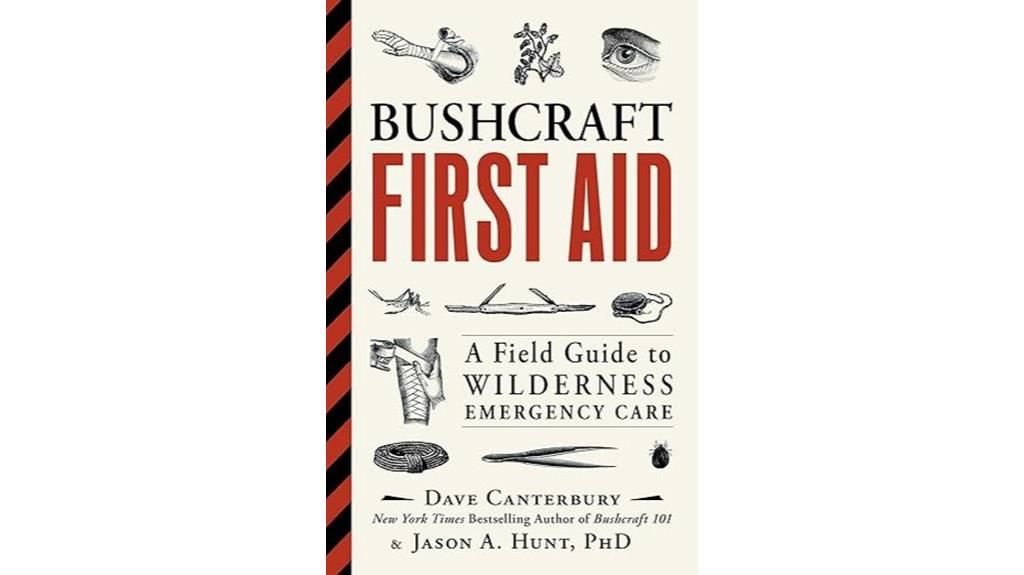
Looking for a practical guide that equips you to handle emergencies in remote wilderness areas? The Bushcraft First Aid Field Guide by Dave offers thorough, straightforward advice for managing injuries and emergencies far from help. It covers a wide range of scenarios, emphasizing tactics to buy time and resolve issues effectively, with clear instructions, plant identification, and remedies like pine needle tea for vitamin C. Praised for its real-world applicability, the book is perfect for preppers, outdoor enthusiasts, and wilderness travelers. While it has some gaps in advanced procedures, its practical focus makes it an invaluable resource to carry in any survival kit.
Best For: outdoor enthusiasts, preppers, and wilderness travelers seeking a practical, easy-to-follow first aid guide for remote emergency situations.
Pros:
- Clear, concise instructions with real-world applicability
- Includes plant identification and natural remedies like pine needle tea
- Highly portable and valued as a safety resource in outdoor gear
Cons:
- Lacks detailed procedures for advanced treatments such as setting broken bones or managing infections
- Does not provide guidance for long-term care or post-emergency procedures
- May require additional training or resources for comprehensive wilderness medical care
Waterproof Wilderness Skills Pocket Guide
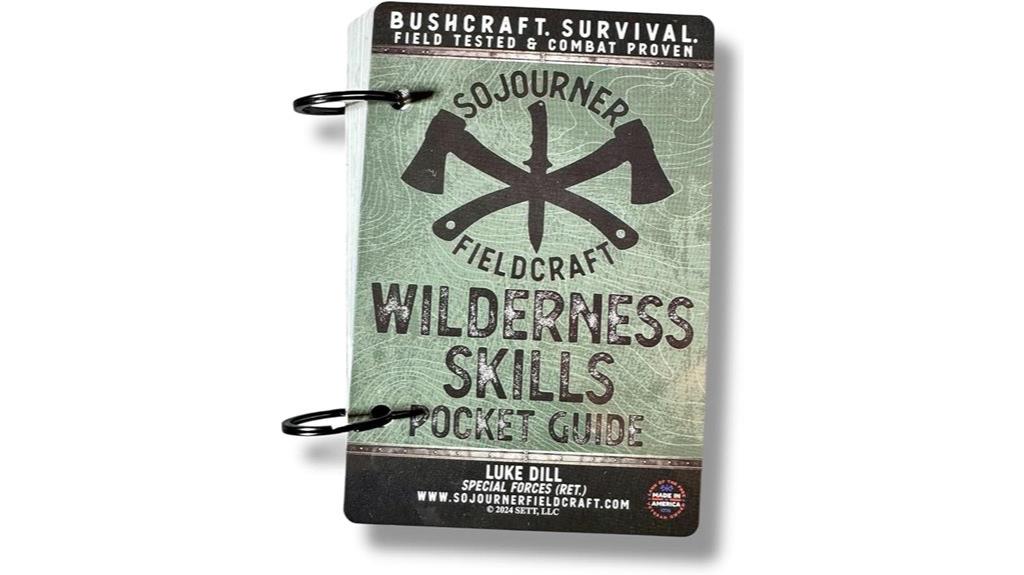
A standout feature of the Waterproof Wilderness Skills Pocket Guide is its durability and compact design, making it perfect for outdoor enthusiasts who need quick, reliable access to survival skills. Its 4×6 inch size and lightweight 4.5 ounces mean it easily fits in a pocket or backpack. Made with weather-resistant, waterproof plastic and bound with a metal ring, it stays intact even in tough conditions. The guide includes 11 essential cards covering shelter, fire, first aid, knots, water purification, and navigation, all field-tested by a retired Green Beret. It’s a reliable, portable resource for camping, hiking, or any wilderness emergency.
Best For: outdoor enthusiasts, hikers, and campers seeking a durable, comprehensive, and portable survival reference.
Pros:
- Highly durable waterproof plastic construction ensures long-lasting use in tough outdoor conditions
- Compact 4×6 inch size and lightweight design make it easy to carry in pockets or backpacks
- Field-tested by a retired Green Beret, providing reliable and expert outdoor survival information
Cons:
- Includes only 11 cards, which may limit coverage of some specialized or advanced survival topics
- Ferro rod fire starter sold separately, requiring an additional purchase for complete fire-starting kit
- Plastic pages might be less flexible or more prone to wear over extended heavy use
Bushcraft 101: Wilderness Survival Field Guide
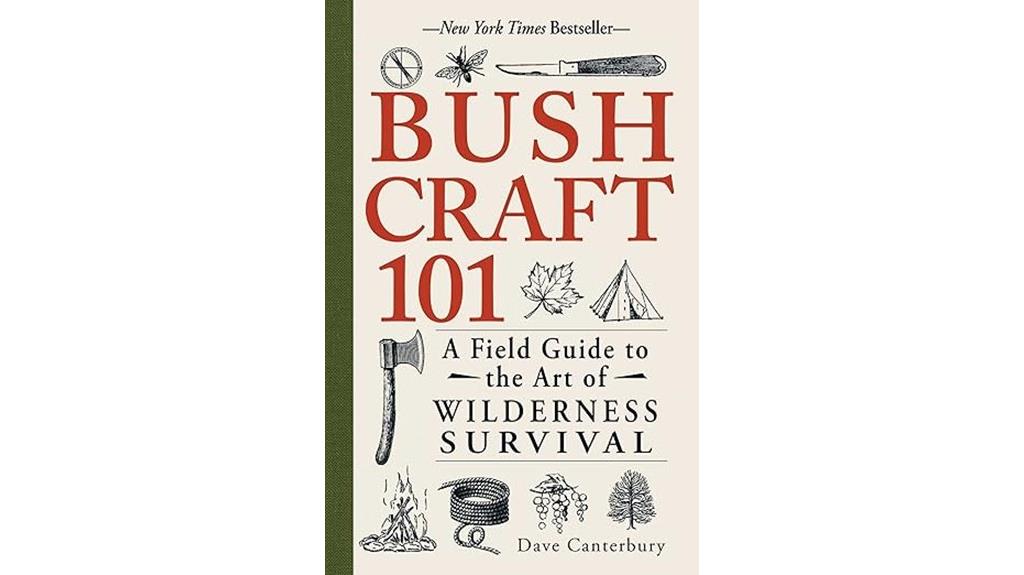
Bushcraft 101: Wilderness Survival Field Guide stands out as an ideal resource for beginners, outdoor educators, and parents teaching kids essential wilderness skills. Authored by Dave Canterbury, it offers a practical, beginner-friendly approach that combines traditional woodsman knowledge with modern survival techniques. The book covers core skills like fire-starting, shelter building, and resource management, emphasizing the “Five Cs of Survivability.” Its clear, systematic layout makes learning straightforward, though it could benefit from more visuals. Lightweight and portable, it’s perfect for quick reference during outdoor adventures. Overall, it’s a reliable, educational tool that builds confidence and foundational skills for anyone venturing into the wild.
Best For: beginners, outdoor educators, and parents teaching kids essential wilderness skills looking for a practical, easy-to-understand guide.
Pros:
- Clear, systematic layout makes learning straightforward for novices
- Emphasizes core survival skills with practical tips for real-world application
- Compact and lightweight, ideal for quick reference during outdoor activities
Cons:
- Lacks sufficient illustrations or diagrams to fully support visual learners
- Gear recommendations include expensive brands, which may be cost-prohibitive for some users
- Focuses on basic skills; may not satisfy advanced or expert bushcrafters seeking in-depth techniques
The Official U.S. Army Survival Manual Updated

If you’re seeking a survival manual that’s both extensive and easy to understand, the Official U.S. Army Survival Manual Updated is a top choice. Covering 19 chapters and 428 pages, it offers practical skills like basic medicine, identifying venomous reptiles, sourcing wild food, and weather forecasting through cloud reading. The manual emphasizes mental resilience and self-reliance, with clear visuals and diagrams that make complex concepts accessible. Its organized, error-free content makes it a reliable reference for beginners and veterans alike. Plus, it’s affordable and compact, making it an essential addition to any preparedness kit or outdoor adventure.
Best For: outdoor enthusiasts, veterans, and beginners seeking a comprehensive, easy-to-understand survival guide.
Pros:
- Clear visuals and diagrams enhance understanding of complex concepts
- Organized, error-free content makes it a reliable reference
- Affordable and compact, ideal for inclusion in emergency kits
Cons:
- Might lack in-depth detail for advanced survival scenarios
- Limited coverage on specific topics like advanced medical procedures
- Some users may prefer more technical or specialized manuals
Bushcraft Gear for Survival and Manual Auger for Camping

For outdoor enthusiasts who prioritize durability and versatility, the manual auger stands out as an essential piece of bushcraft gear for survival and camping. It’s perfect for drilling holes in wood, setting up tents, building shelters, or crafting furniture—all without needing electricity or fuel. Its welded Scotch eye blade guarantees toughness, while the leather-wrapped drill bit adds extra functionality, acting as a hammer if needed. The simple lever mechanism makes it easy to operate in the wilderness. Compact and durable, this tool fits seamlessly into any bushcraft backpack, making it a reliable choice for survivalists, hikers, and outdoor adventurers alike.
Best For: bushcraft enthusiasts, survivalists, hikers, and outdoor adventurers seeking a durable, versatile manual auger for camping and wilderness projects.
Pros:
- No need for electricity or fuel, ideal for remote outdoor use
- Welded Scotch eye blade ensures high durability and resistance to breakage
- Multi-functional with a leather-wrapped drill bit that can also be used as a hammer
Cons:
- Requires manual effort, which may be tiring over extended use
- Limited to drilling in softer materials like wood; less effective on hard or rocky terrain
- Smaller size may require additional tools for larger or deeper holes
Hunting & Gathering Survival Manual: Primitive & Wilderness Survival Skills
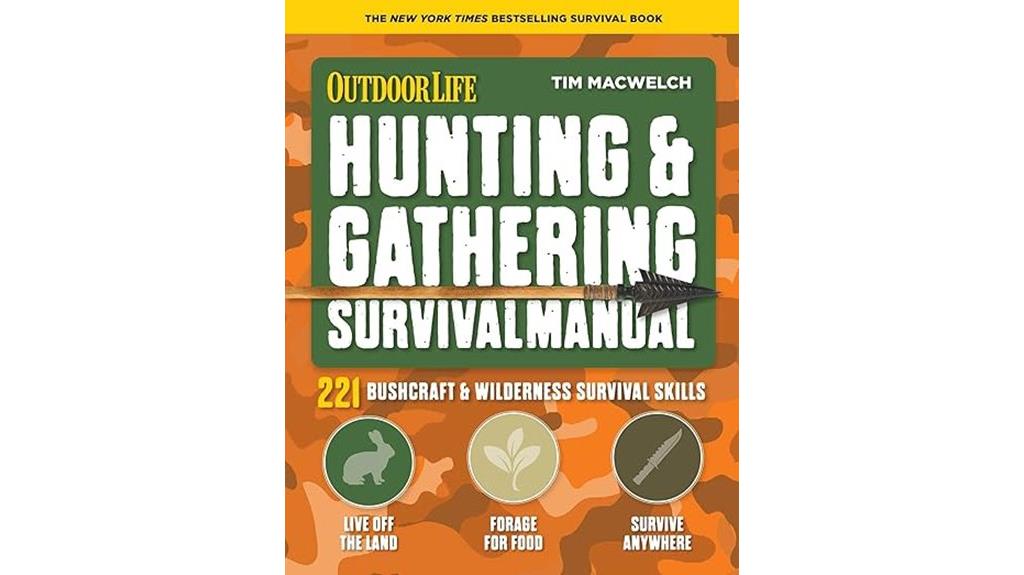
The “Hunting & Gathering Survival Manual” stands out as an essential resource for anyone serious about mastering primitive and wilderness survival skills, especially those who prefer relying on nature rather than modern equipment. It offers detailed guidance on identifying edible plants, trapping, hunting, and fishing, along with bushcraft techniques. The manual’s thorough illustrations and practical advice make complex skills accessible for beginners and seasoned outdoor enthusiasts alike. I’ve found it invaluable for off-grid living and emergencies, as it emphasizes resourcefulness and sourcing from nature. Keeping a copy or digital version in my gear boosts my confidence and preparedness, making it a must-have survival reference.
Best For: outdoor enthusiasts, survival beginners, and preppers seeking comprehensive guidance on primitive and wilderness survival skills without relying on modern equipment.
Pros:
- Highly detailed and well-illustrated, making complex skills easy to understand
- Suitable for both beginners and experienced outdoor enthusiasts
- Emphasizes resourcefulness by focusing on sourcing from nature rather than modern tools
Cons:
- May contain minor packaging or delivery issues, such as damaged boxes
- Could be less applicable for advanced hunters or fishermen with specialized skills
- Some users might find it less tailored to highly technical or professional survival scenarios
The MeatEater Guide to Wilderness Skills and Survival
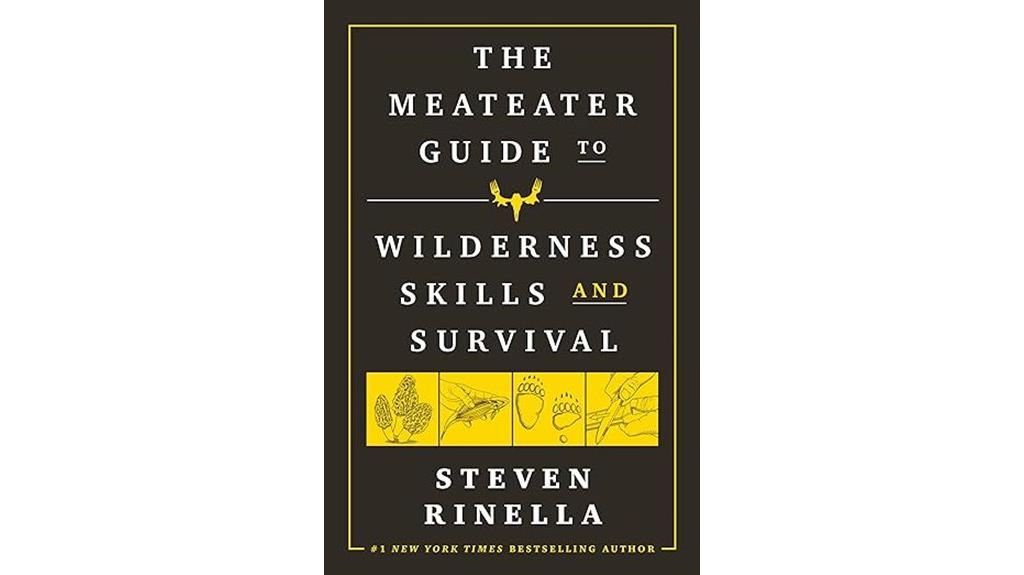
The MeatEater Guide to Wilderness Skills and Survival stands out as an ideal resource for both beginners and seasoned outdoorsmen seeking practical, easy-to-follow advice. I find it highly accessible, with well-organized content, entertaining storytelling, and humor that keeps me engaged. It offers detailed tips, step-by-step instructions, and useful lists, making it a valuable tool for outdoor adventures. While some wish for more visuals and color photos, the durable hardcover ensures it can withstand outdoor conditions. This guide boosts confidence, promotes self-reliance, and is perfect for anyone interested in honing survival skills, whether for serious expeditions or backyard practice.
Best For: outdoor enthusiasts, beginners, and experienced survivalists seeking a practical, reliable guide to wilderness skills and survival techniques.
Pros:
- Highly accessible, well-organized, and entertaining, making complex skills easy to learn.
- Comprehensive coverage of survival techniques, hunting, and edible plants with detailed instructions.
- Durable hardcover design suitable for outdoor use, inspiring confidence and self-reliance.
Cons:
- Some readers wish for more visual aids, such as color photos and illustrations, to enhance understanding.
- Limited inclusion of real-life stories or case studies to illustrate concepts further.
- The physical book does not come waterproof, which may be a concern for rugged outdoor conditions.
Weyland Bushcraft Hand Auger Wrench for Survival and Camping
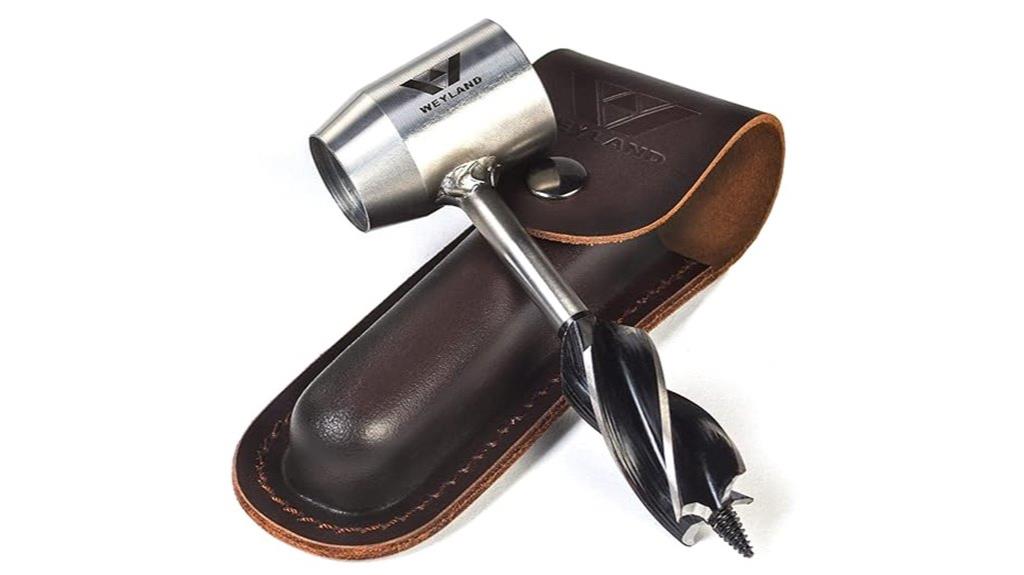
If you’re serious about bushcraft and outdoor DIY projects, the Weyland Bushcraft Hand Auger Wrench stands out as a durable and versatile tool. Its solid construction, with through-wall welds and smooth finish, ensures strength and reliability. The sharp auger and cutting edges make drilling, batoning, and creating pegs straightforward, especially with the tool’s substantial weight for handling tough tasks. The thick, well-stitched leather sheath keeps it protected and ready for use in the field. While some find limited in-depth peg-making or challenging peg removal, overall, this high-quality tool is a dependable addition to any survival or camping kit.
Best For: outdoor enthusiasts, bushcrafters, and DIYers seeking a durable, versatile hand auger wrench for shelter building, woodworking, and survival tasks.
Pros:
- Solid construction with through-wall welds and smooth finish for enhanced strength and reliability
- Sharp auger and cutting edges facilitate drilling, batoning, and peg-making with ease
- Heavyweight design improves handling during tough outdoor tasks and provides durability
Cons:
- Peg-making depth limited to 3/4 inch, restricting use for larger projects
- Some users experience difficulty removing pegs or nails from drilled holes, requiring extra tools or force
- Longer augers would be beneficial for larger diameter projects, but are not included
Survival Hacks Book: 200+ Wilderness Survival Tips

Looking for a survival guide that offers quick, practical tips you can easily apply in emergency situations? “Survival Hacks: Over 200 Ways to Use Everyday Items for Wilderness Survival” by Creek Stewart delivers exactly that. It’s packed with inexpensive, innovative hacks—like making fire starters from cotton balls and petroleum jelly or waterproofing gear with shipping envelopes. Designed for all skill levels, the book emphasizes preparing at home and using basic tools and debris to survive long-term. While it lacks detailed visuals, its straightforward tips and web resources make it accessible and useful. I’ve found many of these hacks handy, especially in unexpected scenarios.
Best For: outdoor enthusiasts, preppers, and beginners seeking quick, practical wilderness survival tips using everyday items.
Pros:
- Offers over 200 innovative, cost-effective survival hacks that can be performed with common household items
- Focuses on practical techniques suitable for all skill levels, emphasizing self-reliance and preparedness
- Includes web links and resources to expand knowledge and support hands-on practice
Cons:
- Lacks detailed visuals such as photos, diagrams, or step-by-step illustrations, which may hinder comprehension
- Contains some tips that are obvious, impractical, or less applicable in real emergency scenarios
- The overall content may feel limited, with only a handful of truly essential hacks for survival situations
Ultimate Wilderness Gear Guide
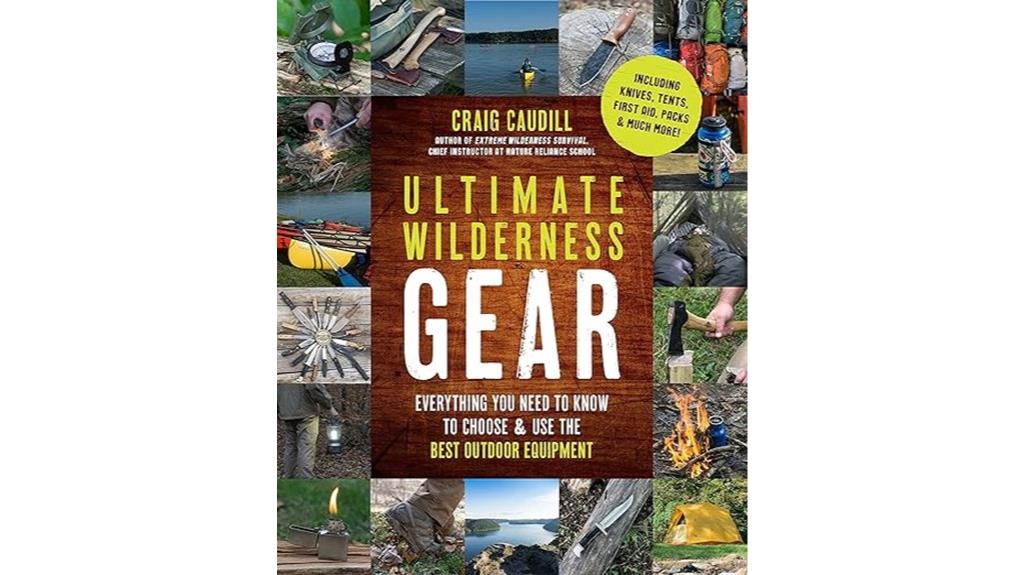
Whether you’re new to the outdoors or an experienced adventurer, the “Ultimate Wilderness Gear Guide” by Craig Caudill offers invaluable advice to help you choose the right equipment. This book goes beyond simple shopping lists, focusing on understanding gear features, functions, and practical considerations. Caudill shares personal stories, historical insights, and real-world examples to help you make informed decisions. It covers essential categories like camping, hiking, and survival gear, emphasizing quality and purpose. With detailed tips and brand recommendations, this guide guarantees you optimize your kit, avoid unnecessary expenses, and enjoy outdoor adventures safely and confidently.
Best For: outdoor enthusiasts of all skill levels seeking practical, well-informed guidance on selecting and optimizing their wilderness gear.
Pros:
- Offers detailed insights into gear features, functions, and practical considerations.
- Includes personal stories, historical context, and real-world examples for engaging learning.
- Provides brand recommendations and tips to help avoid unnecessary expenses and improve gear choices.
Cons:
- Some readers may find the technical details and historical content more in-depth than needed for casual outings.
- The comprehensive scope might be overwhelming for complete beginners without prior outdoor experience.
- As a physical book, it may lack interactive digital features or updates found in online resources.
Tiny Pocket Survival Guide EDC Reference Skills Field Emergency Disaster Rural Urban Preparedness
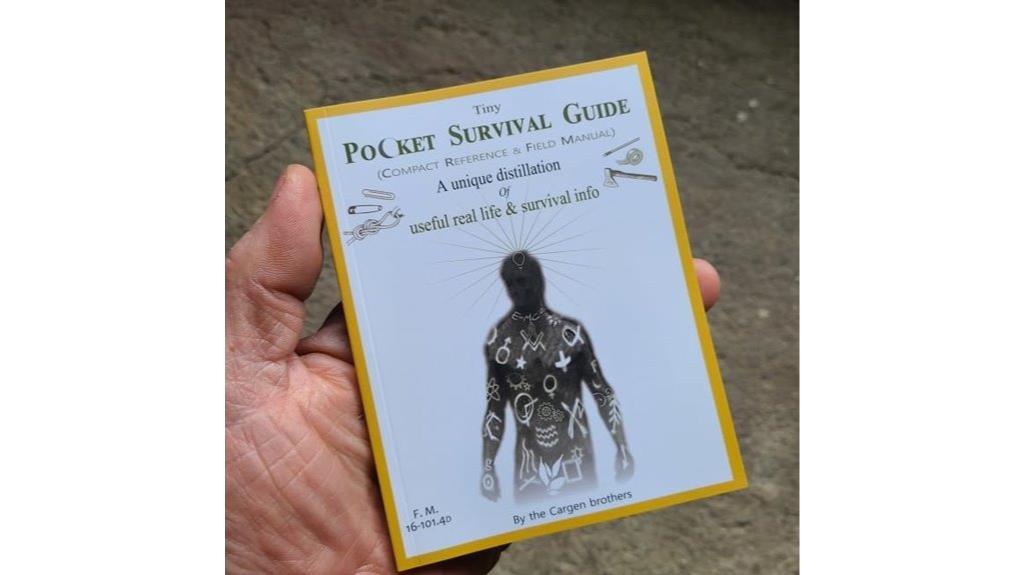
The Tiny Pocket Survival Guide is an essential tool for anyone who wants quick, reliable access to survival skills in a compact format. It covers critical areas like shelter building, fire starting, water procurement, and basic first aid, all designed for rapid reference. Whether you’re in a rural or urban environment, it emphasizes problem-solving and preparedness for various scenarios. It also includes communication signals, navigation techniques, and safety tips, ensuring you’re ready for emergencies. Weighing just 2 ounces and water-resistant, this guide fits easily in your pocket, making it perfect for everyday carry and field use. It’s a smart addition to any survival gear collection.
Best For: outdoor enthusiasts, preppers, and anyone seeking quick-access survival knowledge in a compact, everyday carry format.
Pros:
- Lightweight and water-resistant for durability and portability
- Comprehensive coverage of survival, first aid, and communication skills
- Easy to carry and quick to reference in emergency situations
Cons:
- Limited space may mean some topics are covered only briefly
- Not a substitute for hands-on training or detailed manuals
- May require supplementary resources for advanced survival techniques
Factors to Consider When Choosing Wilderness Survival Manuals

When choosing a wilderness survival manual, I concentrate on how well it aligns with my skill level and covers the essential topics. I also evaluate the quality of visual aids and how practical the advice is for real-world situations. Finally, I seek manuals that address various environments to make certain I’m ready for any scenario.
Skill Level Suitability
Choosing the right wilderness survival manual depends heavily on matching its content to your current skill level. I recommend selecting a guide that offers foundational techniques if you’re a beginner, or more advanced tactics if you’re experienced. Look for clear explanations and step-by-step instructions that suit your proficiency without overwhelming you with complex jargon or assuming prior knowledge. Practical exercises or scenarios aligned with your ability to practice are also essential for effective skill-building. Make sure the manual’s complexity and terminology match your familiarity with wilderness survival—nothing too basic or overly technical. Ideally, choose a manual that allows for scalable learning, so you can develop your skills and confidence gradually as you gain experience.
Content Depth Balance
Selecting a wilderness survival manual that strikes the right balance in content depth guarantees you gain practical skills without feeling intimidating. A good manual provides enough technical detail to be useful while remaining accessible for beginners. Too much information can be overwhelming, making it hard to retain essential skills, especially when you’re under stress. On the other hand, overly simplified guides risk leaving out critical techniques needed during emergencies, which could be dangerous. The ideal manual matches your skill level, offering foundational knowledge with options to explore more advanced topics later. Including clear step-by-step instructions, troubleshooting tips, and visual aids ensures concepts are easy to understand without sacrificing necessary technical depth. This balance helps you learn confidently and prepares you for real-world situations.
Visual Aids Quality
High-quality visual aids play a vital role in effective wilderness survival manuals because they help clarify complex techniques quickly and accurately. Clear diagrams, detailed illustrations, and sharp photographs make it easier to understand procedures under stress. Well-designed visuals can bridge language barriers, enabling faster comprehension in emergencies. The clarity, resolution, and accuracy of images are crucial; blurry or poorly rendered visuals can cause misinterpretation and mistakes. Visual aids should be properly labeled and complement the textual instructions, guiding you step-by-step through each process. Including diverse formats like charts, infographics, and photos caters to different learning styles and enhances retention. Ultimately, high-quality visual aids ensure you grasp critical survival techniques swiftly, increasing your confidence and effectiveness in real-world situations.
Practical Application Focus
When evaluating wilderness survival manuals, it’s essential to focus on those that emphasize practical, step-by-step techniques that you can directly apply in real-life situations. I look for guides that break down skills like shelter building, fire-making, and first aid into clear, actionable instructions. Visual aids such as diagrams or photos are vital—they help me understand complex tasks quickly and accurately. I also prefer manuals that cover a variety of scenarios, including wilderness, urban, and disaster contexts, so I’m prepared for anything. Troubleshooting tips and real-world stories are invaluable—they show me how to adapt techniques when conditions change unexpectedly. Most importantly, I seek guides that promote hands-on practice and mental preparedness, ensuring I can confidently use my skills when it truly counts.
Environment Coverage Range
Choosing the right wilderness survival manual means considering whether it covers the environments you’re most likely to face. I look for books tailored to specific terrains like deserts, forests, mountains, or Arctic zones, ensuring the techniques are relevant. It’s essential the manual includes strategies for unique features such as snow caves or water crossings, depending on the environment. I also check if it offers guidance on climate-related challenges like extreme heat, freezing cold, or high humidity, so I’m prepared for conditions I’ll encounter. Additionally, environment-specific hazards like venomous animals, poisonous plants, or avalanches should be addressed. A thorough manual blends general survival principles with environment-specific adaptations, maximizing my chances of staying safe and effective in any wilderness setting I might face.
Portability and Durability
A survival manual’s portability and durability are essential for ensuring it remains a reliable resource in the field. I look for manuals that are compact and lightweight enough to fit in a pocket, pack, or survival kit, so I can carry them effortlessly during outdoor adventures. Durability is equally important; waterproof, tear-resistant materials help the manual withstand rain, mud, and rough handling. Binding types like spiral-bound or waterproof pages prevent damage from frequent use and exposure, keeping the information accessible over time. Clear, high-contrast printing and minimal small fonts improve legibility in various lighting conditions, making quick reference easier. Weatherproof covers or laminated pages further protect the manual from water, dirt, and wear, ensuring it remains functional when I need it most.
Author Expertise Credibility
The credibility of a wilderness survival manual heavily depends on the author’s expertise and real-world experience. I look for authors with solid backgrounds in survival situations, such as military service, rescue missions, or wilderness guiding. These credentials mean their advice has been tested and proven in actual scenarios. Recognized authors often hold certifications, awards, or extensive field experience that bolster their authority. Including practical, scenario-based insights from seasoned survivalists ensures the advice is applicable and reliable. Additionally, authors who update their manuals regularly show commitment to staying current with new techniques, technology, and environmental changes. Trustworthy authors provide peace of mind, knowing their guidance is rooted in proven expertise and real-life application—crucial factors when choosing a manual for survival situations.
Frequently Asked Questions
Which Survival Manual Covers Urban and Rural Emergency Scenarios?
The “SAS Survival Handbook” by John “Lofty” Wiseman covers both urban and rural emergency scenarios effectively. I rely on it because it provides practical strategies for survival in diverse environments, whether you’re in the city or deep in the wilderness. The book’s extensive tips on shelter, signaling, and first aid make it an essential guide for any emergency, helping me stay prepared no matter where I am.
Are Digital or Printed Manuals More Reliable in Survival Situations?
Think of survival manuals as your trusty compass in a storm. I believe printed manuals are more reliable because they don’t depend on batteries or signals. When chaos hits, digital devices can fail or run out of power, leaving you stranded. A well-worn printed manual is like an old friend—always there, ready to guide you through the thick of it, no matter how digital world chaos unfolds.
Do These Manuals Include Dietary Advice for Prolonged Wilderness Stays?
Yes, many wilderness survival manuals include dietary advice for prolonged stays. I’ve found that they often cover essential topics like identifying edible plants, fishing, trapping, and rationing food effectively. These tips help me stay nourished and maintain energy during extended periods in the wild. I always make sure my manual has updated, practical information so I can rely on it when faced with survival challenges.
How Often Should I Update My Wilderness Survival Manual?
I recommend updating your wilderness survival manual at least once every two years. Technology and best practices evolve, so staying current guarantees you’re prepared with the latest techniques. I also keep an eye out for new editions or supplementary guides. Regular updates help me feel confident that I have the most reliable information, especially for critical skills like navigation, shelter, and safety in unpredictable conditions.
Are There Manuals Tailored for Specific Climates or Regions?
Yes, there are manuals tailored for specific climates or regions. I recommend choosing guides that match your area’s environment, like desert, mountain, or jungle survival. These manuals provide targeted advice on local plants, animals, weather, and terrain challenges. I always carry a region-specific manual when I travel or hike, as it helps me prepare better and increases my chances of staying safe in any wilderness situation.
Conclusion
Think of these manuals as your trusted compass on a wild, uncharted journey. They’re like lanterns guiding you through darkness, revealing hidden paths when you least expect it. With each skill and tip, you become more than just a survivor—you become a resilient explorer ready to face any challenge. Keep these guides close; they’re your map, your shelter, and your secret weapon in the wilderness’s endless adventure.





